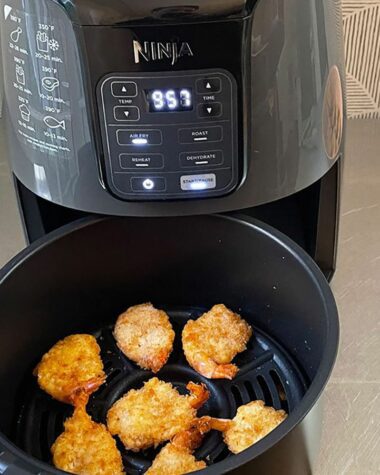You’re having a viewing party with your close friends and decide to run downstairs toward the refrigerator to get some ice cream. But suddenly, you notice your appliance is frozen at the back.
And whether you are equipped with a frost-free refrigerator or not, it may suffer from several issues which ultimately result in unfavorable outcomes. A refrigerator that freezes all your foods is problematic and could indicate that the equipment needs to be adjusted or needs care. Regardless of the cause, it must be handled as soon as possible.
This May Also Interest You: Why Should The Refrigerator And Freezer Be This Cold (A Guide)
Everyone who owns a refrigerator probably has encountered an issue like this at some point. You’ll be surprised one morning, finding out that your water, milk, veggies, and fruits are frozen solid. This could happen for lots of reasons. Here, we at DaDongNy will go over the most typical causes and how you could deal with them.
Is The Back Of Your Refrigerator Freezing?
Don’t worry; your refrigerator probably needs to be fixed. There are several reasons why frost or ice may form in a refrigerator.
We’ve compiled a list of the most typical causes and quick and easy solutions. Suppose your refrigerator is still frozen after trying these quick cures. In that case, it might be the perfect time for you to call a qualified technician for problem diagnosis and repairs or invest in an entirely new model.
Five Reasons Why Your Refrigerator Is Freezing Everything At The Back
- Ice Maker Gets Clogged
The ice maker inside your refrigerator is a small freezer hidden inside your refrigerator. A switch can be found toward the rear of the ice maker. It instructs the ice maker to begin freezing water and producing cubes if empty. If the ice maker becomes frozen shut while the lever is in the empty position, it will continue to freeze even if the bin is full. This can cause frost to form in the refrigerator. It can eventually ruin the entire ice maker.
| How To Fix This |
Empty the ice bin and remove the ice surrounding the switch area.Make sure that the switch can be moved easily.Keep an eye on the ice maker as it creates a fresh supply of ice.Once the switch does not turn on after the ice bin is full, the ice maker may need to be fixed or replaced. |
This May Also Interest You: No Fuss, No Muss: A Quick And Easy Way On How To Unclog Refrigerator Drain For All Of Us
- Opening And Closing The Door On Multiple Occasions
If you live with a large family or just one teenager, you might find yourself closing the freezer shortly after they have grabbed a bottle of soda. Like a faulty seal, an open door requires the refrigeration system to operate more than it normally should. That being said, ice could accumulate faster inside the refrigerator as well as around the coils.
| How To Fix This |
If you live with a large family or just one teenager, you might find yourself closing the freezer shortly after they have grabbed a bottle of soda. Like a faulty seal, an open door requires the refrigeration system to operate more than it normally should. That being said, ice could accumulate faster inside the refrigerator as well as around the coils. |
- Blocked Vents In Aop987nd Out Of The Refrigerator
Active air circulation is used in today’s frost-free refrigerators to keep a consistent humidity and temperature inside the refrigerator. Ice can develop on the air vent at the back of the refrigerator if containers and food debris block it. These obstructions interfere with the airflow and force the compressor to work harder to circulate cold air throughout the unit.
These air intake vents are usually located at the back of the refrigerator. Too much debris across the back of the refrigerator and the wall causes the same issue.
| How To Fix This |
| Here’s what to do if the air vent is located inside: Look for the air vent inside your refrigerator and freezer compartment. Adjust the food so there’s at least 3 to 10 cm of space surrounding the vent. If the freezer is covered with ice, switch off the refrigerator to eliminate the chunks of ice. Here’s what to do if the air vent is located outside: If the air vent on the outside of the refrigerator has become clogged, suck out any debris and dust using a vacuum cleaner. To clean it completely, use a washcloth and dishwashing soap. |
- A Faulty Door Seal
Every refrigerator is manufactured with magnets and an elastic door gasket to maintain the door closed. When the door is closed, no hot air will pass through the appliance. Warm air could enter the refrigerator if the door seal is faulty, causing the coils to run constantly. This will result in an accumulation of ice within the refrigerator.
If you lay a piece of paper between the refrigerator door and the rubber gasket that keeps the door closed, the sheet of paper should not slide. If it does, you’ll need to replace the whole thing.
| How To Fix This |
A door seal replacement takes simply a few minutes and costs around $16 or more. You can get a gasket designed for your refrigerator or an all-purpose one. A generic refrigerator door gasket may need to be trimmed to fit perfectly. Empty the refrigerator and place the food and beverages inside a portable cooler to keep it cool.Pull out the old gasket from the refrigerator door. Make sure the door is clean. To get inside the nooks and crevices, use cotton swabs.Replace the gasket with a new one.Shut the door and allow your refrigerator to reach a temperature of at least 41 °F before returning all the contents you removed earlier. before putting back all the contents you removed earlier. |
This May Also Interest You: Seal Your Worries Away With These Five Simple Steps For Replacing A Refrigerator Door Gasket
- The Fridge’s Temperature Settings Are Too Low
If the temperature in your refrigerator has been set low enough, the refrigeration system will operate too long, generating frost inside the appliance and beginning to freeze your food. The temperature in your refrigerator needs to be set between 36.5 °F and 41 °F.
| How To Fix This |
Look within your refrigerator for the temperature controls around the corner. Instead of using exact temperatures, most refrigerators have a numerical system. Increase the temperature on the control panel to a warmer level. Insert a refrigerator thermometer into the middle of your refrigerator and allow the appliance to maintain its setting for 24 hours before rechecking the ambient temperature. Continue adjusting the refrigerator until it is at its right temperature. |
How To Prevent A Refrigerator From Freezing Everything
Now that we’ve covered the most common reasons for ice formation within your refrigerator and how to deal with them, we’ll go through how to prevent a refrigerator from freezing your foods. Continue reading to find out more:
- Organize The Food More Effectively
Air vents are commonly used in refrigerators in order to maintain air from flowing smoothly. The vent is located on the side of or over the top shelf. This is the point at which cold air reaches your fridge. Keep this air vent free from any kind of dust and debris. Otherwise, the food around or blocking it will freeze. There should be a minimum of five inches of room around the vent.
Adjust the placement of the first shelf when the food only freezes at the top shelf. The frigid air from the vent sometimes blasts air all over the place. If that’s the case, lowering the food should help. You might find food freezing at the bottom of a bottom-freezer refrigerator. If that’s the case, air venting through the freezer compartment underneath is most likely to blame. In this situation, you can lift the shelf once more.
Also, if your fridge has nothing, restock it with additional items. A well-filled refrigerator allows food to absorb the possible excess cold air. If there is little food in the fridge, the frigid air falls to the bottom, so keep it full but not overfull; otherwise, the contents may not cool correctly. A full-stocked refrigerator keeps temperatures level, saving energy costs, so it’s a win-win situation.
At the very least, reorganize the food in the refrigerator if restocking is not an option. Spread it all out fairly. Raw meat products and other perishable goods should be kept on lower shelves. This keeps them cool and prevents leaks if they spoil.
On the other hand, milk and other dairy products should be stored on the bottom shelf, with milk towards the back of the shelf. Refrigerate butter and soft cheeses inside the refrigerator door. Fresh food thrives in storage compartments such as a crisper drawer.
- Adjust The Temperature Of The Freezer
If the problem remains after you’ve adjusted the refrigerator’s temperature gauge and reorganized all the food, check the freezer’s temperature. The issue might be something other than your refrigerator, but the freezer is too cold.
Bottom freezers, in particular, are susceptible to many problems when freezing food in the freezer compartment. So, make sure the freezer temperature is not less than 0°F. If the refrigerator’s temperature is too low, raising the temperature to 0°F may help.
Assess your ice maker’s settings. You might want to change those settings if it’s running all day. A constantly running ice maker might cause the freezer to get overly cold, allowing the refrigerator to freeze abnormally.
- Check If The Door Magnets Are Still Functional
Refrigerator doors typically have permanent magnets to keep them closed completely. These magnets create an airtight barrier, keeping cold air from leaving as well as warm air from infiltrating. In rare circumstances, refrigerator gaskets can lose their magnetism.
Warm air may penetrate and lead to ice accumulation whenever the refrigerator seals in your equipment fail to function properly.
Gently slide open and shut the refrigerator door. If the doors do not appear entirely closed or the refrigerator begins to open within seconds of closing, the magnets might be weaker than usual.
It’s also possible that the seals themselves are dirty. In that situation, a mild water and detergent solution should suffice. Replace all magnets which look worn, bent, or otherwise broken.
- Clean The Coils On Your Refrigerator
Coils in refrigerators are used to chill and condense freon or other refrigeration fluids. To ensure optimal operation, keep the refrigerator coils clear of dirt, debris, and dust.
Because they can’t effectively release heat when these coils have become jammed, the compressor has to operate harder to keep up proper cooling. In some circumstances, when the refrigerator operates too hard that it normally should, the consequence is frozen food and drinks.
- Change The Thermostat
Not all refrigerators are built for a lifetime. The older appliance is, the higher the probability it will need service and replacement parts. Refrigerator thermostats are a frequent component that fails after a couple of years.
Once the refrigeration unit reaches the perfect temperature, the thermostat notifies the compressor to stop cooling. However, these thermostats are susceptible to breakdowns resulting in over-cooling as they operate continuously. Refrigerator thermostats, fortunately, are affordable and simple to replace.
You may be able to clean the contacts temporarily with a contact cleaner, but you must replace the thermostat if it is faulty.
- Examine The Freezer Damper
Some refrigerator models come with a damper in the refrigerator’s freezer compartment. The damper is a device that works like a flap that keeps air flowing inside the refrigerator.
The damper essentially controls the ambient temperature of the refrigerator. Excess cold air could reach the refrigerator if the damper isn’t working properly. This lowers the ambient temperature inside your refrigerator, causing food and beverages to freeze.
In some circumstances, food from the freezer could fall into the damper, preventing it from opening and closing. Make sure to check the damper to verify it is clear of any obstacles that may exist. You’ll need to have it repaired if it’s broken or jammed open.
- Examine The Control Panels
The main control and the temperature control panel are the two most common controls which may lead to ice accumulation. While control panels are rarely the source of a problem, more is needed to completely rule out the potential for these parts to malfunction. However, before deciding on replacing these parts, it is best to properly double-check every one of the other parts.
- Main Control Panel
It is extremely unlikely that the main control panel is defective, although it is possible. That being said, you must assess every other component within your refrigerator just before you replace the controls. The main control board may be responsible if no other problems are found.
It is strongly advised that you employ someone with expertise to replace a control panel, particularly if you are unfamiliar with the entire procedure. You can order the part with the manufacturer and model number to avoid wasting money.
- Temperature Control Panel
- Get In Touch With The Manufacturer
If neither of the methods mentioned above works, the refrigerator may have an issue with its mechanics. These problems require the attention of an experienced professional. If your device is still under protection, you could potentially be able to arrange an inspection for no charge.
Reach out to the manufacturer of the device you’re using. The technician might first lead you through a few troubleshooting tips, but they will send a technician if the issue still can’t be fixed.
If your refrigerator is out of warranty, you’ll have to pay for an appliance service provider to come out and inspect it.
FAQs
- Should There Be Ice Accumulation On The Back Wall Of A Fridge?
A little accumulation of ice on the back wall of your refrigerator is not unusual. It should not, however, have a heavy coating of ice on top of it or be entirely covered in ice.
If there is a lot of ice on your refrigerator’s back wall, try one of the abovementioned solutions before hiring a professional or replacing your equipment entirely.
- Why Does My Refrigerator Ice Up Against The Back Wall?
As previously said, there are several explanations. However, condensation is most likely responsible for the problem. Condensation can form on the back wall of your refrigerator because it is often the coolest place.
Any moisture that enters the refrigerator from warm air will condense and become water, which may ice up on the back wall.
- How Do I Remove Ice From The Back Of My Refrigerator?
Defrosting the entire unit is the best way to get undesired ice from the back as well as the side of the refrigerator.
- Remove every food item from the refrigerator.
- Unplug the refrigerator from the wall.
- Place a dish of boiling water inside the refrigerator and freezer.
- In order to accelerate the melting process, use a hair dryer. But only for a little while, as it is possible to exceed the temperature and damage the hair drier and the equipment.
- As the ice melts, wipe it up with a washcloth.
This May Also Interest You: A Comprehensive Guide On How To Properly Defrost Your Samsung Refrigerator
- How Much Time Does It Take To Defrost A Refrigerator Manually?
A full manual might take up to 2 hours but could extend more, depending on the amount of ice accumulated in your refrigerator or freezer. It should take at most four or five hours if you have a maximum of one inch of ice surrounding the ventilation holes in your refrigerator compartment.
The ice must start melting before the refrigerator’s walls can do so. That takes longer than a few minutes.
Remember that it will take a lot of time for the refrigerator to cool down enough for you to refrigerate foods properly.
Bottomline
That’s all there is to it! With this blog, you are familiar with why your refrigerator may be freezing at the back and, most importantly, what can be done about it.
A refrigerator frequently accumulates frost or small amounts of ice on the back wall for short periods. However, if your refrigerator keeps on freezing or has a thick film of frost on it, there is most likely a larger issue at hand. Before you call a professional or visit your local store and buy a new unit, try these quick repairs to rule out any simple answers. These could help save you an enormous amount of money.
To learn more about refrigerators and how this valuable piece of equipment chills the food and beverages inside, including your breast milk, check out the post here.
Articles You May Be Interested In
- A Cooler Choice: Whirlpool v.s GE Refrigerators (Full Guide)
- Refrigerator Check: LG v.s Samsung Refrigerators (Full Guide)
- Cool Tech Showdown: Frigidaire v.s Whirlpool Refrigerators (Full Guide)
- Fridge Favorites: Bosch v.s LG Refrigerators (Full Guide)
- Cooling Conundrum: Whirlpool v.s Samsung Refrigerators (Full Guide)
- Tale Of The Tape: Maytag v.s Whirlpool Refrigerators (Full Guide)
- Fridges in Focus: Thermador v.s Sub-Zero Refrigerators (Full Guide)
- Fridge Frenzy: Sub-Zero v.s Viking Refrigerators (Full Guide)
- The Big Chill: Whirlpool v.s KitchenAid Refrigerators (Full Guide)
- Refrigerator Bout: Whirlpool v.s LG Refrigerators (Full Guide)









